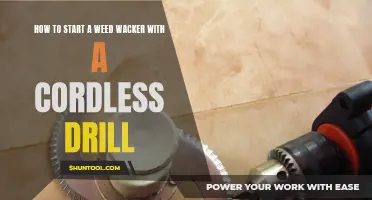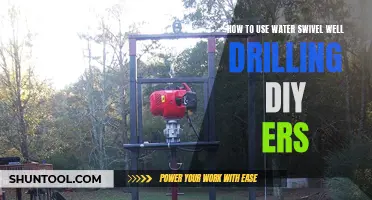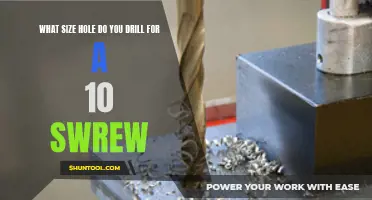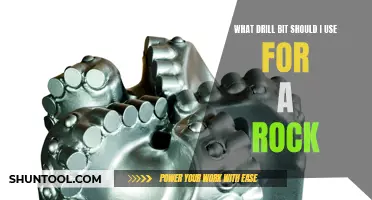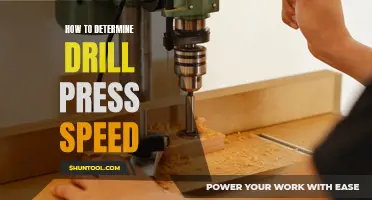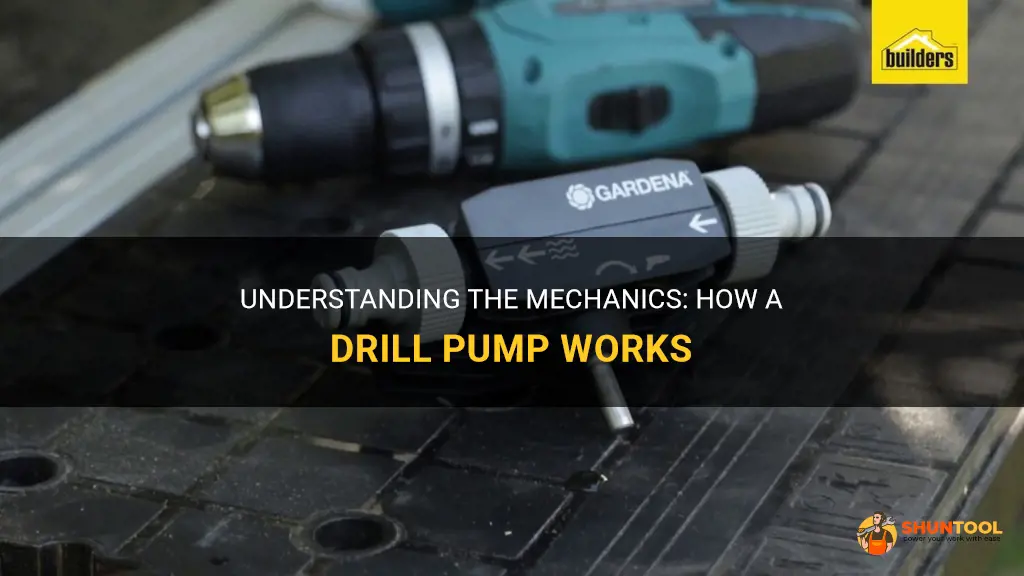
A drill pump is a versatile tool that can turn your ordinary power drill into a powerful water or fluid transfer system. Whether you need to empty out a flooded basement or transfer fuel from one container to another, a drill pump can come to the rescue. By attaching the drill pump to the chuck of your drill, the rotation of the drill causes the impeller inside the pump to spin. This spinning impeller creates a suction and draws in the water or fluid through the intake hose. As the fluid enters the pump, it is then pushed and expelled out through the outlet hose, providing a quick and efficient transfer process. With the ability to adapt to various power drills, the drill pump is a reliable and convenient tool for any fluid transfer needs.
| Characteristic | Value |
|---|---|
| Power Source | Electric, battery-powered, or manual |
| Priming | Requires priming before use or self-priming |
| Flow Rate | Varies depending on model, can range from 100-1500 gallons per hour |
| Maximum Lift | Varies depending on model, can range from 10-30 feet |
| Maximum Head | Varies depending on model, can range from 15-60 feet |
| Inlet/Outlet Size | Varies depending on model, can range from 1/2 inch to 1 inch |
| Impeller Type | Centrifugal |
| Material | Usually made of durable plastic or metal |
| Compatibility | Can be used with most types of liquids, including water, oil, and fuel |
| Usage | Used for transferring liquids from one container to another, such as emptying a flooded basement or transferring water from a pool |
| Portability | Lightweight and compact, easy to transport |
| Maintenance | Requires regular cleaning and inspection to prevent clogs and damage |
| Noise Level | Varies depending on model, typically produces moderate noise levels |
| Cost | Varies depending on model and brand, can range from $10 to $100+ |
What You'll Learn

What is a drill pump?
A drill pump is a versatile and handy tool that can save you time and effort when it comes to pumping liquids. Whether you need to drain your swimming pool, empty a flooded basement, or transfer water from one container to another, a drill pump can make the task a breeze. In this article, we will explore what a drill pump is, how it works, and provide step-by-step instructions on how to use one effectively.
A drill pump is a small, portable device that is powered by a standard drill. It is designed to be attached to the drill's chuck, which allows it to harness the rotational motion of the drill to create a pumping action. The pump consists of an impeller, which is a rotating component that moves the liquid from the inlet to the outlet, and a housing that encloses the impeller and channels the liquid flow. The pump is typically made of durable materials such as plastic or metal to withstand the pressure and corrosion that can occur when pumping different liquids.
To use a drill pump, you will need a drill with a chuck that can accommodate the pump's shaft. Before attaching the pump, make sure the drill is turned off and unplugged for safety. Next, remove the chuck's key or loosen the chuck to open it up. Insert the pump's shaft into the chuck and tighten it securely. Once the pump is attached, you can plug in the drill and turn it on.
Before you begin pumping, it's important to create a clear path for the liquid to flow. Position the inlet hose into the container or area where you want to pump the liquid from. Make sure the inlet hose is securely attached to the pump's inlet, using hose clamps if necessary, to prevent any leakage. Place the outlet hose into the container or area where you want the liquid to be pumped to. Again, ensure the outlet hose is securely attached to the pump's outlet to prevent any leaks.
Once everything is set up, you can start pumping by turning on the drill. The rotational motion of the drill will transfer to the impeller, creating a suction force that draws the liquid from the inlet into the pump. The impeller then propels the liquid through the housing and out through the outlet, effectively transferring the liquid from one location to another.
It's important to note that drill pumps have limitations. They are best suited for transferring water or other thin liquids, and may not be suitable for pumping thick or viscous substances. Additionally, drill pumps are not designed for continuous use and should not be run for extended periods of time. It's important to take breaks and allow the pump to cool down if needed.
In conclusion, a drill pump is a practical and convenient tool for pumping liquids. Whether you need to drain a pool, remove water from a flooded space, or transfer liquids between containers, a drill pump can make the task easier and more efficient. By following the step-by-step instructions outlined above and keeping the limitations in mind, you can effectively use a drill pump to tackle your pumping needs.
Understanding the Fractional Size of a Q Drill Bit
You may want to see also

How does a drill pump attach to a power drill?
A drill pump is a useful tool that can be attached to a power drill to aid in various pumping tasks. Whether you need to transfer water from one location to another or remove fluids from a tank, a drill pump can simplify the process.
Attaching a drill pump to a power drill is a straightforward process that can be done in a few simple steps. Here is a step-by-step guide on how to attach a drill pump to a power drill:
Step 1: Ensure Compatibility
Before attaching a drill pump to a power drill, it is essential to make sure that they are compatible. Check the specifications and requirements of both the drill pump and the power drill to ensure that they can be used together. This includes checking the chuck size of the power drill and the connection size of the drill pump.
Step 2: Prepare the Power Drill
Start by preparing the power drill for attachment. If you have been using the power drill for other tasks, remove any drill bits or attachments that may be currently attached. This will provide a clean and stable surface for attaching the drill pump.
Step 3: Prepare the Drill Pump
Next, prepare the drill pump for attachment. Most drill pumps come with a connection point that allows them to be attached to a power drill. This connection point is typically located at the inlet or outlet of the pump. Check the instructions that came with the drill pump to locate the connection point and ensure that it is clean and free of debris.
Step 4: Attach the Drill Pump to the Power Drill
Once both the power drill and the drill pump are prepared, it is time to attach them together. Align the connection point of the drill pump with the chuck of the power drill. Depending on the design of the drill pump, you may need to use an adapter or an additional attachment to secure the connection. Carefully tighten the chuck of the power drill to secure the drill pump in place.
Step 5: Test the Connection
After attaching the drill pump to the power drill, it is a good practice to test the connection before using it for any pumping tasks. Start the power drill at a low speed and gradually increase the speed while observing the attachment. Ensure that the drill pump remains securely attached to the power drill and that no vibrations or wobbling occur. If any issues are detected, stop the power drill immediately and recheck the attachment.
With these simple steps, you can easily attach a drill pump to a power drill. However, it is important to note that the specific process may vary depending on the brand and model of both the drill pump and the power drill. Always refer to the instructions and guidelines provided by the manufacturers for the most accurate and safe attachment method.
One example of a drill pump that can be attached to a power drill is the Wayne PC2 Portable Transfer Water Pump. This drill pump is specifically designed for transferring water and can be easily attached to most power drills. It features a standard 3/4-inch garden hose connection that can be connected to the power drill using a compatible adapter. With a flow rate of up to 340 gallons per hour, this drill pump is a versatile tool for various water transfer applications.
In conclusion, a drill pump can be attached to a power drill to facilitate pumping tasks. By following the steps outlined above and ensuring compatibility between the drill pump and the power drill, you can easily attach the two together. Always refer to the instructions provided by the manufacturers for the most accurate attachment method.
Finding the Perfect Hole Size for Drilling an O2 Bung
You may want to see also

What is the purpose of a drill pump?
A drill pump is a versatile tool that can be used to transfer liquids such as water, oil, and other fluids from one place to another. It is essentially a small, portable pump that can be attached to a drill, making it easy to operate and transport. The purpose of a drill pump is to provide a convenient and efficient way to transfer fluids without the need for large and expensive pumping equipment.
One of the main applications of a drill pump is for pumping water out of flooded basements or other areas. In the event of a water leakage or flooding, a drill pump can quickly and efficiently remove the water, preventing further damage to the property. With the power of a drill, the pump can handle large volumes of water, making it an essential tool for homeowners and professionals alike.
Drill pumps also have various uses in automotive maintenance and repair. For example, when changing the oil in a car, a drill pump can be used to extract the old oil from the engine, making the process much easier and less messy. It can also be used to transfer fluids such as coolant or brake fluid from one container to another, eliminating the need to manually pour or siphon the fluid.
In addition to its practical applications, a drill pump can also be used for scientific experiments and research. For instance, in a chemistry lab, a drill pump can be used to circulate solvents or other liquids through a system for mixing or analysis. The pump's compact size and ease of use make it a convenient tool for researchers who need to transfer fluids quickly and accurately.
Using a drill pump is fairly straightforward. First, you need to attach the pump to the drill chuck, ensuring that it is secure and properly aligned. Next, you can immerse the pump into the liquid you want to transfer, making sure that the intake hose is submerged. Once everything is in place, you can start the drill and the pump will begin transferring the fluid.
It's important to note that drill pumps are not designed for heavy-duty or continuous use. They are typically used for small to medium-sized jobs and should not be run for extended periods of time. It's also important to clean and properly maintain the pump after each use to ensure its longevity and performance.
In conclusion, the purpose of a drill pump is to provide a convenient and efficient way to transfer fluids using a portable and versatile tool. Whether it's removing water from a flooded area, changing the oil in a car, or conducting scientific experiments, a drill pump offers a practical and easy solution. By being aware of its limitations and proper usage, you can make the most of this handy tool in various applications.
Choosing the Right Drill Bit Size for Turning a Bowl: A Comprehensive Guide
You may want to see also

How does a drill pump transfer liquid or fluid?
A drill pump is a versatile tool that allows you to transfer liquids or fluids easily and efficiently. Whether you need to empty a flooded area, transfer water from one location to another, or even pump out a hot tub, a drill pump is a handy tool to have.
So how does a drill pump transfer liquid or fluid? Let's break it down step by step.
Step 1: Attach the drill pump to a power drill
To use a drill pump, you first need to attach it to a power drill. The pump typically comes with a male thread that screws onto the drill's chuck, just like a drill bit.
Step 2: Submerge the pump
Next, you need to submerge the pump into the liquid or fluid that you want to transfer. Make sure the pump is fully submerged, as running it dry can cause damage.
Step 3: Activate the power drill
Once the pump is submerged, activate the power drill by turning it on. The rotating motion of the drill will transfer into the pump, creating suction and pushing the liquid or fluid through the pump.
Step 4: Monitor the flow
As the liquid or fluid is being pumped, you need to monitor the flow. Some drill pumps have a built-in flow control valve or knob that allows you to adjust the speed of the pump. By adjusting the flow control, you can control the rate at which the liquid or fluid is being transferred.
Step 5: Direct the output
Finally, you need to direct the output of the pump. Most drill pumps have an output spout or hose attachment that allows you to direct the liquid or fluid to a specific location. For example, if you are pumping out a flooded area, you can attach a hose to the pump and direct the water away from the affected area.
Now that we've covered the basic steps, let's dive deeper into the science behind how a drill pump actually transfers liquid or fluid.
When the power drill is activated, it rotates the pump's impeller. The impeller consists of blades or vanes that spin in a circular motion. As the impeller spins, it creates centrifugal force, which pushes the liquid or fluid towards the outer edges of the pump.
At the outer edges of the pump, there is a housing or chamber that collects the liquid or fluid. As the liquid or fluid accumulates in the housing, it creates pressure, which forces the liquid or fluid out of the pump through the output spout or hose attachment.
The efficiency of a drill pump depends on various factors, including the power of the drill, the design of the pump, and the viscosity of the liquid or fluid being transferred. Generally, drill pumps are most effective for transferring non-viscous liquids, such as water or oil.
To illustrate the effectiveness of a drill pump, let's consider an example. Imagine you have a hot tub that needs to be drained. Instead of manually scooping out the water or using a traditional electric pump, you can use a drill pump.
By attaching the drill pump to a power drill and submerging it in the hot tub, you can easily drain the water. The centrifugal force created by the rotating impeller will push the water towards the outer edges of the pump, where it will be collected and forced out through the output spout or hose attachment. In no time, your hot tub will be emptied, and you can move on to other tasks.
In conclusion, a drill pump is a powerful tool that can efficiently transfer liquids or fluids. By following the step-by-step process and understanding the science behind how it works, you can effectively use a drill pump for various applications. Whether you need to drain a flooded area, transfer water from one location to another, or pump out a hot tub, a drill pump is a reliable and convenient solution.
The Right Approach to Increasing Drill Bit Size
You may want to see also

Can a drill pump be used for different types of liquids or fluids?
A drill pump is a versatile tool that can be used for various applications. One common question that arises is whether a drill pump can be used for different types of liquids or fluids. The answer to this question is yes, a drill pump can be used for different types of liquids or fluids, but there are some important considerations to keep in mind.
Firstly, it is important to understand the capabilities and limitations of the specific drill pump that you are using. Different models of drill pumps have different specifications in terms of the types of liquids they can handle. Some drill pumps are specifically designed for transferring water, while others are capable of handling more viscous fluids such as oil or even chemicals. It is important to consult the user manual or product specifications of your drill pump to determine its compatibility with different types of liquids.
Secondly, it is important to consider the compatibility of the drill pump materials with the specific liquid or fluid that you are working with. Drill pumps are typically made from materials such as plastic, aluminum, or stainless steel. These materials may have varying degrees of compatibility with different types of liquids. For example, some plastics may not be compatible with certain chemicals, leading to degradation or damage of the pump. It is crucial to ensure that the materials of the drill pump are suitable for the type of liquid or fluid that you are planning to pump.
Another important consideration is the flow rate and pressure requirements of the specific liquid or fluid. Different liquids or fluids have different viscosities and densities, which can impact the performance of a drill pump. For example, thicker fluids may require a more powerful drill pump or a slower pumping rate to effectively transfer the liquid. It is important to select a drill pump that can meet the flow rate and pressure requirements of the specific liquid or fluid that you are working with.
Lastly, it is essential to properly clean and maintain the drill pump after each use, especially when switching between different types of liquids or fluids. Residual fluids or contaminants from one type of liquid can impact the performance or contaminate the subsequent type of liquid being pumped. Proper cleaning and maintenance will ensure the longevity and optimal performance of the drill pump.
In conclusion, a drill pump can be used for different types of liquids or fluids, but it is important to consider the compatibility of the specific drill pump with the type of liquid or fluid being pumped. It is crucial to consult the user manual or product specifications of the drill pump, ensure the compatibility of the materials, consider the flow rate and pressure requirements, and properly clean and maintain the drill pump for optimal performance. By following these considerations, a drill pump can be effectively used for various types of liquids or fluids.
The Best Techniques for Drilling in a Screw Eye
You may want to see also
Frequently asked questions
A drill pump works by connecting to a power drill and using its rotational motion to move water or other fluids from one location to another. The drill pump typically has inlet and outlet hoses, and when the power drill is turned on, it creates a suction that draws fluid into the pump's inlet and pushes it out through the outlet.
Yes, a drill pump can generally be used with any power drill. However, it is important to check the specifications and compatibility of the pump and the drill before using them together. Some drill pumps may have specific requirements or limitations regarding the drilling speed or power of the drill.
Drill pumps are designed to handle various fluids, including water, oil, and some chemicals. However, it is important to check the manufacturer's instructions and guidelines to ensure that the particular drill pump can handle the specific type of fluid you need to transfer. Some fluids may be too thick or corrosive for certain drill pump models.
The efficiency of a drill pump at moving fluids depends on several factors, including the power of the drill, the design and quality of the pump, and the properties of the fluid being transferred. In general, drill pumps are relatively efficient at moving fluids, but it is important to ensure that the drill pump is properly sized and suited for the specific application.
Drill pumps are generally not designed for continuous pumping over long periods of time. They are more commonly used for smaller, intermittent pumping tasks. Continuous pumping with a drill pump may put excessive strain on the drill and the pump, potentially causing overheating or damage. It is best to consult the manufacturer's guidelines and recommendations for the specific drill pump model to determine its suitability for continuous pumping.


